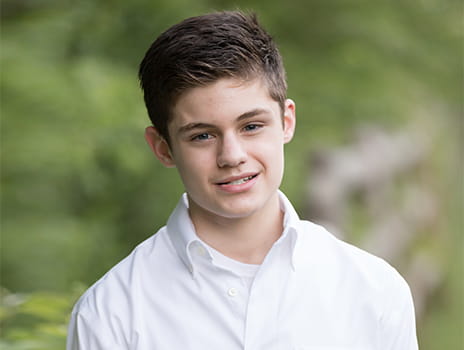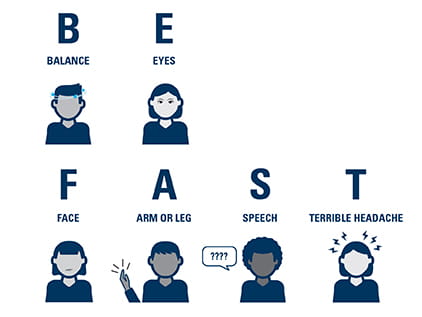Young Athlete Battles Stroke

In recognition of the upcoming Martin Luther King Jr. Day holiday, some of The University of Kansas Health System’s offices will have modified hours on Monday, January 19.
The University of Kansas Health System is experiencing a high volume of patients seeking care for influenza and other respiratory illnesses. Whether you plan to visit the health system or not, learn how to keep yourself healthy.

November 01, 2018
In May 2015, Kyle Goble, 11, didn't feel well. But it was spring in Kansas City, and the mild headaches he was experiencing were attributed to allergy season.
"We wrote off those early symptoms," says Kyle's father, Keith. "I get mild headaches and seasonal allergies myself. Serious issues just weren't on our radar."
The headaches persisted for several days. Then, Kyle's parents noticed he was moving slowly, dawdling, apparently wasting time. He ran very late getting ready for baseball practice.
"In retrospect, this was our first indication that something was going on," Keith says. "Baseball is Kyle's passion. He was always on time for practices and games. Running late was totally out of character for him."
The unusual behaviors continued, and the Gobles made an appointment for Kyle to see his primary care provider. The morning of the appointment, Kyle told his parents his vision was fuzzy and he couldn't see well. With the doctor's visit just a couple of hours off, the Gobles waited for the appointment time to come.
We wrote off those early symptoms. Serious issues just weren't on our radar. – Keith Goble
The family physician examined Kyle and recommended a visit to a satellite office of the local children's hospital. There, Kyle was evaluated for migraines and given pain medication that "made him feel really loopy," Keith says. "His condition didn't improve, so the next day, we took him to the ER."
The Gobles took Kyle to the emergency department at Children's Mercy Kansas City. Pediatric neurologists believed Kyle might have experienced a series of small strokes and admitted him.
"Five days later, we thought Kyle was ready to go home," Keith says. "He had weakness on his right side, but we expected to treat it with aspirin and physical therapy. If you walked into the room and looked around, you would have asked who the patient was. He was himself. There was nothing unusual to notice."
But then, as the family prepared for discharge, Kyle's condition deteriorated suddenly. He was "out of it," Keith says, and he began to vomit. Kyle's care team ordered another MRI, which at last revealed something concrete. A blood clot had moved into Kyle's basilar artery, blocking blood flow to the brainstem.
Kyle was rushed to The University of Kansas Health System, where the region's uniquely qualified multidisciplinary care team was ready to take immediate action in the Advanced Comprehensive Stroke Center. Neurointerventionalists and anesthesiologists were waiting for Kyle in the ambulance bay and immediately transferred him to the neurointerventional suite.
"We knew from the team at Children's Mercy that Kyle had a blocked artery that could result in the worst possible stroke, 'locked-in syndrome,' in which a patient is fully aware but unable to move anything but the eyes," says neurointerventionalist Michael Abraham, MD.
Under direct X-ray guidance, Dr. Abraham advanced catheters and wires into Kyle's basilar artery followed by a stent retriever, used to grasp and pull out the clot, opening the occluded basilar artery.
"Though Kyle experienced a small stroke during the hours of the blockage, the combination of a collaborative team and advanced technology prevented a devastating event," Dr. Abraham says. "We quickly initiated physical, occupational and speech therapies, which Kyle continued during inpatient rehab. With his hard work and the great support of his family, Kyle has made a remarkable recovery."

In its immediate aftermath, the stroke robbed Kyle of speech and the use of his right side. It damaged his eyesight, with his left and his right eyes no longer functioning in tandem.
Kyle faced a challenging recovery and continued therapy to attack the deficits the stroke had caused. In outpatient rehabilitation, he worked with care providers for several hours every day. In 2016, he returned to school. He continues therapy through weekly visits and at-home exercises he completes on his own and with the help of his parents.
Now 14 and in the 8th grade, Kyle has returned to baseball, joining a team of athletes with special needs. He is a coveted lefty and excels on the pitching mound and at first base. Kyle also enjoys playing basketball.
"Kyle works really hard," Keith says. "If something can be accomplished, he will figure out a way to do it. He challenges himself. Many things are more difficult than they used to be, but he finds a way to connect with new opportunities."
The Gobles praised Kyle's providers not only on the quality of care they delivered, but on the kindness that always accompanied it.
"Everyone, and I mean everyone, we came into contact with at The University of Kansas Health System was wonderful," Keith says. "Their compassion and care throughout Kyle's stay was a blessing for our whole family. We will be forever grateful to this exceptional staff."
Dr. Abraham emphasizes multiple factors that came together in a positive outcome.
"The early, well-orchestrated approach of Children's Mercy and our anesthesia and interventional stroke teams followed by early rehab allowed us to help Kyle return to being an active kid, once again enjoying his favorite sports."
Keith also credits Kyle himself for the hard-fought progress he has made since the stroke put his life at risk.
"He is such an inspiration," Keith says. "It's been overwhelming to see his will to improve. He is the toughest person I've ever known. It's a blessing to call him my son."